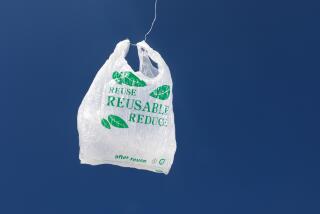The Nose Knows
- Share via
Everyone who has picked up his or her clothes at a dry cleaner has experienced it. You detect a slight -- sometimes stronger -- chemical odor when you take the clothes out of the plastic wrapping. You might have even wondered whether the smell signals danger.
It does. The chemical you smell -- perchloroethylene, or PCE -- is bad for the environment, a health hazard for employees at dry-cleaning facilities and a problem for communities where dry cleaners are located. Yet, a government agency’s innovative approach to PCE may eventually eliminate that odor.
PCE is the favorite cleaning solvent of the vast majority of dry cleaners in Southern California for some delicate garments. At first, cleaners relied on a petroleum solvent to do the job, but it posed a fire risk. In a search for a less combustible solvent, a number of chlorine-based chemicals were introduced, among them PCE, whose lower costs and better cleaning qualities made it the cleaner of choice.
Because dry-cleaning businesses are typically small neighborhood operations, emissions from a single dry-cleaning plant are slight when compared with, say, an oil refinery. But exposures from thousands of neighborhood dry cleaners have produced major health and environmental problems. As early as the 1970s, research pointed to PCE’s potential harm to human health and the environment as a toxic air contaminant, an occupational hazard and a probable human carcinogen.
Given such risks, government agencies sought to minimize PCE exposure by requiring dry cleaners to install expensive control technologies and devices. But the problem persisted and became more and more of an issue as the nature and extent of PCE hazards were better understood. Environmentalists and community members were unhappy because they believed serious risks remained unmitigated. Dry cleaners were unhappy because of numerous government rules and regulations, horrendous liability problems and control technologies that increased costs and reduced the effective life of their machines. Some consumer groups, notably Consumers Union, worried about that chemical smell on clothes.
As regulation of PCE dry cleaning intensified in the 1990s, so did interest in the development of alternatives to PCE. Significantly, this search paralleled a shift in approach to pollution control, from managing the problem after its creation to preventing it in the first place. The dry-cleaning industry highlights the limits of the more reactive approach: Compliance with regulations is hard to monitor and enforce, and end-of-pipe controls such as vapor-recovery technology are expensive, costly to maintain and ultimately ineffective.
A new technology recently introduced, professional wet cleaning, illustrates the preventive approach. It uses computer-controlled washers and dryers, formulated nontoxic detergents and specialized finishing equipment to clean delicate garments in water. Because it removes PCE from the cleaning process, professional wet cleaning eliminates all the risks and regulations associated with its use.
Our research, including a new report titled “Commercialization of Professional Wet Cleaning,” indicates that this more environmentally friendly system is viable. It cleans clothes as well as a PCE-based process. It is more profitable. Some costs, including the upfront costs of the machines, are cheaper.
Cleaners who have made the switch express strong satisfaction with wet cleaning. Take Moon Noh, a Korean immigrant who had been dry cleaning for 27 years at a small shop in San Clemente. He started wet cleaning about 15 months ago, when he needed to replace his old PCE-based dry-cleaning equipment and wanted to avoid the hassle of the PCE-regulatory regime. Noh also suffered from dizziness, headaches, fatigue, runny nose and heightened allergic reactions that he associated with exposure to PCE. As a professional wet cleaner, Noh’s costs are lower, his customers are pleased with the results and he no longer has headaches or suffers from any of the other possible health effects of PCE exposure.
The viability of professional wet cleaning prompted the staff of South Coast Air Quality Management District to take the unprecedented step of proposing a rule calling for a 15-year phaseout of PCE starting in July 2004. Because dry-cleaning equipment generally lasts about 10 years, the proposal will not require dry cleaners to replace their PCE-dependent machines until the end of their useful life.
On Friday, the AQMD board heard public testimony, and it will vote next month on the phaseout rule. If the board adopts the staff proposal, it would be an example of government rule-making solving a problem by preventing it instead of perpetuating it. For businesses, workers, the community and the environment, it would be a winning proposition.
More to Read
Inside the business of entertainment
The Wide Shot brings you news, analysis and insights on everything from streaming wars to production — and what it all means for the future.
You may occasionally receive promotional content from the Los Angeles Times.










